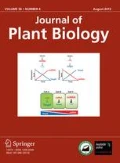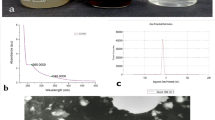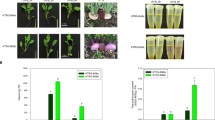Abstract
Aloe vera L. is an excellent resource for medication. Selenium-enriched aloe can act as a functional food to human health. To understand the molecular mechanisms underlying selenium accumulation in Aloe vera L., we characterized the metabolic and transcriptome responses of aloe leaves under different Na2SeO4 levels (0, 200, and 400 mg/L) treatments. Aloe leaves spraying with exogenous selenium fertilizer showed a significant increase in total Se content compared with those under non-treatment control, and no distinct differences were observed between 200 and 400 mg/L Se treatment. Non-targeted metabolic profiling revealed that Se treatment triggered the accumulation of antioxidants, including amino acid and derivatives, phenols, flavonoids, terpene, as well as indole derivatives. Consistent with metabolic changes following Se treatment, the transcript level of genes involved in Se assimilation and Se-response showed dramatically increase, such as those encoding sulfate transporter, antioxidants, phytohormone signaling, transcription factors, and phenols metabolites, suggesting Se assimilation generally accompanied with antioxidant and pathogen defense. This study exhibited comprehensive insights on Se response in Aloe vera L., and provided us with targeted genes for genetic engineering, thereby improving the therapeutic value of aloe.





Similar content being viewed by others
References
Anderson JW (1993) Selenium interactions in sulfur metabolism. Sulfur Nutrition and Assimilation in Higher Plants—Regulatory, Agricultural and Environmental Aspects pp 49–60
Bawankar R, Singh P, Babu S (2014) Bioactive compounds and medicinal properties of Aloe vera L.: an update. J Plant Sci 2:102–107
Bent AF, Kunkel BN, Dahlbeck D, Brown KL, Schmidt R, Giraudat J, Leung J, Staskawicz BJ (1994) RPS2 of Arabidopsis thaliana: a leucine-rich repeat class of plant disease resistance genes. Science 265:1856–1860
Besset S, Vincourt JB, Amalric F, Girard JP (2000) Nuclear localization of PAPS synthetase 1: a sulfate activation pathway in the nucleus of eukaryotic cells. FASEB J 14:345–354
Cai Q, Yuan Z, Chen M, Yin C, Luo Z, Zhao X, Liang W, Hu J, Zhang D (2014) Jasmonic acid regulates spikelet development in rice. Nat Commun 5:3476
Dose MM, Hirasawa M, Kleis-SanFrancisco S, Lew EL, Knaff DB (1997) The ferredoxin-binding site of ferredoxin: nitrite oxidoreductase. Differential chemical modification of the free enzyme and its complex with ferredoxin. Plant Physiol 114:1047–1053
Gullner G, Komives T, Király L, Schröder P (2018) Glutathione S-Transferase enzymes in plant-pathogen interactions. Front Plant Sci 9:1836
Harlev E, Nevo E, Lansky EP, Ofir R, Bishayee A (2012) Anticancer potential of aloes: antioxidant, antiproliferative, and immunostimulatory attributes. Planta Med 78:843–852
Hartikainen H (2005) Biogeochemistry of selenium and its impact on food chain quality and human health. J Trace Elem Med Biol 18:309–318
Holben DH, Smith AM (1999) The diverse role of selenium within selenoproteins: a review. J Am Diet Assoc 99:836–843
Howe GA, Schilmiller AL (2002) Oxylipin metabolism in response to stress. Curr Opin Plant Biol 5:230–236
Jasso de Rodrı́guez D, Hernández-Castillo D, Rodrı́guez-Garcı́a R, Angulo-Sánchez JL (2005) Antifungal activity in vitro of Aloe vera pulp and liquid fraction against plant pathogenic fungi. Ind Crops Prod 21:81–87
Jost R, Altschmied L, Bloem E, Bogs J, Gershenzon J, Hähnel U, Hänsch R, Hartmann T, Kopriva S, Kruse C, Mendel RR, Papenbrock J, Reichelt M, Rennenberg H, Schnug E, Schmidt A, Textor S, Tokuhisa J, Wachter A, Wirtz M, Rausch T, Hell R (2005) Expression profiling of metabolic genes in response to methyl jasmonate reveals regulation of genes of primary and secondary sulfur-related pathways in Arabidopsis thaliana. Photosynth Res 86:491–508
Lyi SM, Heller LI, Rutzke M, Welch RM, Li KL (2005) Molecular and biochemical characterization of the selenocysteine se-methyltransferase gene and se-methylselenocysteine synthesis in broccoli. Plant Physiol 138:409–420
Lyons G, Stangoulis J, Graham R (2003) High-selenium wheat: biofortification for better health. Nutr Res Rev 16:45–60
Mindrinos M, Katagiri F, Yu GL, Ausubel FM (1994) The A. thaliana disease resistance gene RPS2 encodes a protein containing a nucleotide-binding site and leucine-rich repeats. Cell 78:1089–1099
Mitchum MG, Yamaguchi S, Hanada A, Kuwahara A, Yoshioka Y, Kato T, Tabata S, Kamiya Y, Sun TP (2006) Distinct and overlapping roles of two gibberellin 3-oxidases in Arabidopsis development. Plant J 45:804–818
Nandal U, Bhardwaj RL (2012) Aloe vera for human nutrition, health and cosmetic use—a review. Int Res J Plant Sci 3:38–46
Okada K, Abe H, Arimura G (2015) Jasmonates induce both defense responses and communication in monocotyledonous and dicotyledonous plants. Plant Cell Physiol 56:16–27
Pedrero Z, Madrid Y (2009) Novel approaches for selenium speciation in foodstuffs and biological specimens: a review. Anal Chim Acta 634:135–152
Pilon-Smits EA, Quinn CF, Tapken W, Malagoli M, Schiavon M (2009) Physiological functions of beneficial elements. Curr Opin Plant Biol 12:267–274
Rayman MP (2000) The importance of selenium to human health. Lancet 356:233–241
Rayman MP (2012) Selenium and human health. Lancet 379:1256–1268
Sánchez-Machado DI, López-Cervantes J, Sendón R, Sanches-Silva A (2017) Aloe vera: ancient knowledge with new frontiers. Trends Food Sci Technol 61:94–102
Santner A, Estelle M (2009) Recent advances and emerging trends in plant hormone signaling. Nature 459:1071–1078
Sultana B, Anwar F, Ashraf M (2009) Effect of extraction solvent/technique on the antioxidant activity of selected medicinal plant extracts. Molecules 14:2167–2180
Thorat I, Jagtap D, Mohapatra D, Joshi D, Sutar R, Kapdi S (2013) Antioxidants, their properties, uses in food products and their legal implications. Int J Food Stud 2:81–104
White PJ, Broadley MR (2009) Biofortification of crops with seven mineral elements often lacking in human diets–iron, zinc, copper, calcium, magnesium, selenium and iodine. New Phytol 182:49–84
Williams J, Phillips AL, Gaskin P, Hedden P (1998) Function and substrate specificity of the gibberellin 3beta-hydroxylase encoded by the Arabidopsis GA4 gene. Plant Physiol 117:559–563
Yamaguchi S, Smith MW, Brown RG, Kamiya Y, Sun T (1998) Phytochrome regulation and differential expression of gibberellin 3beta-hydroxylase genes in germinating Arabidopsis seeds. Plant Cell 10:2115–2126
Yuan K (2008) Functional and genetic analysis of plant transcription factors involved in the plant growth under various environmental conditions. Dissertations and Theses—Gradworks 2:597-600
Zhang Y, Gladyshev VN (2009) Comparative genomics of trace elements: emerging dynamic view of trace element utilization and function. Chem Rev 109:4828–4861
Acknowledgements
We are grateful to Wuhan Metware Biotechnology Co., Ltd. (Wuhan, China) for technical assistance.
Funding
This work is supported by the science and technology program research and development project of Enshi Tujia and Miao Autonomous Prefecture, the Public health branch (No. JCY2017000021) and Science and Technology program of Chengdu (No. 2018YF0501197SN).s
Author information
Authors and Affiliations
Corresponding author
Ethics declarations
Conflict of interest
The authors declare no financial or commercial conflict of interest.
Electronic supplementary material
Below is the link to the electronic supplementary material.
12374_2020_9285_MOESM1_ESM.tiff
Supplementary file1 Supplementary Figure 1. Effect of Se concentration on aloe leaf morphology. The phenotype of aloe leaves after 0 (F), 200 (A), 400 (B) mg/L of Se treatment (TIFF 3643 KB)
12374_2020_9285_MOESM2_ESM.tiff
Supplementary file2 Supplementary Figure 2. Gene ontology (GO) functional classifications of differentially expressed genes (DEGs) in the biological process category. (A) T1_VS_CK. (B) T2_VS_CK (TIFF 31597 KB)
12374_2020_9285_MOESM3_ESM.tiff
Supplementary file3 Supplementary Figure 3. Gene ontology (GO) functional classifications of differentially expressed genes (DEGs) in the cellular component category. (A) T1_VS_CK. (B) T2_VS_CK (TIFF 124745 KB)
12374_2020_9285_MOESM4_ESM.tiff
Supplementary file4 Supplementary Figure 4. Gene ontology (GO) functional classifications of differentially expressed genes (DEGs) in the molecular function category. (A) T1_VS_CK. (B) T2_VS_CK (TIFF 31371 KB)
Rights and permissions
About this article
Cite this article
Zou, Y., Han, C., Wang, F. et al. Integrated Metabolome and Transcriptome Analysis Reveal Complex Molecular Mechanisms Underlying Selenium Response of Aloe vera L.. J. Plant Biol. 64, 135–143 (2021). https://doi.org/10.1007/s12374-020-09285-z
Received:
Revised:
Accepted:
Published:
Issue Date:
DOI: https://doi.org/10.1007/s12374-020-09285-z




